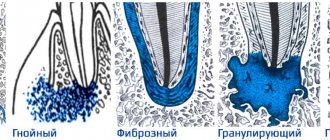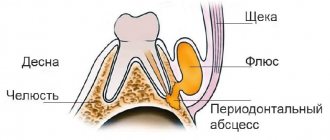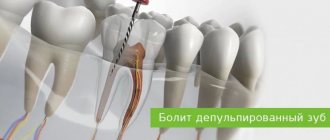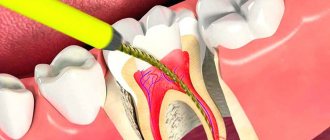Also watch: Dental treatment under a microscopeTreatment of dental cariesEndodontic dental treatment
Any type of dental treatment is aimed at alleviating the patient’s condition and restoring oral health. Pain after dental treatment is a common problem that every person has encountered at least once. In some cases, pain and discomfort are an inevitable consequence of the treatment procedure itself and pass quickly, while in others they indicate the development of complications and poor-quality treatment. You should never ignore pain after dental treatment, but this symptom does not always require repeated dental treatment.
Main causes
Dental treatment can be therapeutic or surgical, and pain can appear after any type of intervention. In most cases, mild or moderate pain is a physiological reaction of tissues to the manipulation, can be easily eliminated by taking anti-inflammatory or painkillers and lasts several days after a visit to the dentist.
Also, pain after dental treatment appears due to complications and violations of the technique of performing medical manipulations. Pain is most often observed after:
- dental fillings;
- root canal treatment;
- removal of a diseased tooth, cyst or granuloma.
The dentist must advise the patient about how the recovery process will occur after treatment and for what symptoms it is necessary to come for another appointment. Also, for comfortable well-being after treatment, anti-inflammatory and, in some cases, antibacterial drugs are prescribed. If, despite following all the doctor’s recommendations, the pain continues to bother you, then it is best to undergo another examination by a specialist.
Headaches after using anesthesia
Very often, dentists use local anesthesia when treating teeth. After undergoing anesthesia, many patients experience headaches. There are several reasons for this type of pain:
- Presence of intolerance to anesthesia or incorrect choice of medication;
- Location of the diseased tooth in remote places;
Most often, the headache is aching in nature and tends to increase when moving the head.
If headaches began after the extraction of a diseased tooth, it is necessary to find the cause of the pain; it may be a complication of the operation.
Pain after dental filling
Dental filling is the most frequently performed treatment procedure in any dental clinic. Due to the high prevalence of caries, each dentist installs several fillings per day. However, even such routine dental manipulation in some cases leads to complications and pain in the patient after treatment.
Slight pain when putting pressure on a filled tooth normally goes away a few days after the filling is installed. To reduce discomfort, you can take anti-inflammatory medications as prescribed by your doctor. But if the pain does not go away and intensifies over time, then this may indicate a complication after dental filling. The main causes of pain are:
- Improper grinding of the filling . Grinding is one of the final stages of tooth restoration using filling materials. This procedure is performed to make the filling smooth and consistent with the patient's bite. If the dentist incorrectly polished the filling and it remains too high, this leads to improper closure of the jaws and injury to the mucous membrane. Also, an unsuitable filling increases the sensitivity of teeth to various irritants (exposure to cold, sour or sweet foods). In such cases, you need to contact your dentist again so that he can adjust the height of the filling and the associated discomfort will no longer bother you.
- Allergy to filling materials . Materials for filling teeth are being improved every year, but the use of even the most modern filling materials cannot completely eliminate the occurrence of an allergic reaction. Symptoms of individual intolerance include swelling, pain, redness of the gums, and a strange taste in the mouth. It is important to understand that similar symptoms occur if you are allergic to a local anesthetic drug. If you suspect that you are allergic to a temporary or permanent filling, you should immediately contact a dental clinic, where the placed filling will be removed from the tooth and filled with other materials.
- Violation of filling technique . Pain after dental treatment sometimes appears if the dentist performed one of the filling stages incorrectly. Pain may occur due to overheating of dentin when preparing a carious cavity with a drill, which leads to inflammation of the pulp. Pain also appears if a special acid is applied for a long time, which improves the fixation of the filling on the tooth, or if the drying technology is disrupted. Any mistake when installing a filling can lead to increased tooth sensitivity and pain. The method for correcting complications is selected individually.
- Development of secondary caries . In some cases, an infectious process can develop under a previously installed filling. This occurs due to insufficient treatment of the carious cavity before installing the filling, as well as due to the loose fit of the filling to the natural tissues of the tooth. The danger of this process is that it is more difficult to visually notice secondary caries. Signs of pathology are darkening of the enamel and pain in the tooth affected by caries. In such cases, the dentist removes the old filling and re-treats the caries.
- Incorrect diagnosis . Pain after filling teeth occurs in cases where the dentist missed the presence of pulpitis in the patient and did not check the condition of the root canals of the tooth. Moreover, even after a high-quality filling is installed, complaints may remain of aching, intense pain of a bursting nature, which intensifies with chewing and biting. To prevent further spread of the inflammatory process, cleaning and treatment of the root canals and removal of the nerve are required. After these manipulations, the canals are filled and the tooth is restored.
To avoid complications and pain after dental filling, a thorough preliminary examination and treatment using high-quality materials by an experienced dentist is necessary. If you experience severe pain after installing a filling, you should immediately contact your doctor.
Means for relieving discomfort
It is advisable to endure moderate pain if it lasts no more than three days. During this period, damaged tissues and nerve endings will be restored, which will help eliminate discomfort.
But sometimes it is not possible to do without the use of painkillers.
A qualified examination will provide the basis for prescribing an adequate course of treatment using anti-inflammatory and analgesic medications.
Based on the results of the examination, the dentist may recommend a toothpaste that reduces enamel sensitivity.
Pain after root canal treatment
The need for root canal treatment worries the vast majority of patients in dental clinics. Many people are afraid of pain during and after the procedure. However, root canal treatment is primarily aimed at eliminating discomfort and pain in advanced stages of caries, when the nerve and pulp of the diseased tooth are involved in the pathological process.
To completely remove the affected tissue, the dentist opens, cleans, prepares and carefully fills the root canals of the tooth. This type of treatment is considered quite invasive and even after proper procedure, mild pain may bother the patient for 1-2 days. Unpleasant sensations do not affect general well-being or ability to work and are reduced by taking anti-inflammatory drugs (paracetamol, ibuprofen).
However, in some cases, severe pain indicates complications of root canal treatment:
- Exit of filling material beyond the root apex . A common complication of root canal treatment that occurs due to improper procedure technique. The patient may be bothered by aching pain that intensifies with load on the tooth. In combination with insufficient treatment of the canal, this can lead to severe periodontal inflammation, as well as intense pain after tooth treatment.
- Mechanical injury from tools . If, while cleaning the canals, the dentist does not fully comply with the accuracy and delicacy of the movements, then perforation (perforation) of the canal and damage to the periodontal tissues with the instrument are possible, followed by the development of inflammation and pain.
- Incomplete canal filling . In some cases, root canals have a complex structure and therefore are not completely filled with filling material. In unsealed areas, conditions are created for the development of an infectious process, which is accompanied by severe pain.
- Development of periodontitis . Advanced stages of caries and pulpitis can lead to inflammation of the periodontal tissues. At the initial stage of development of the disease, changes are not visible on an x-ray. Therefore, even after proper treatment of the tooth canals, the patient may complain of pain and an unpleasant feeling of fullness in the gums. As the disease progresses, granulation tissue or granuloma forms and must be removed surgically. In acute periodontitis, health worsens, the temperature rises, and general weakness is noted.
It is important to remember that during the first days after root canal treatment, slight pain (especially when putting stress on the tooth) is a physiological reaction. But if the pain is pronounced, interferes with meals, sleep and disrupts the usual daily routine, then it is necessary to be examined by a dentist and eliminate the complications that have developed as soon as possible. Treatment tactics in each case are selected individually, depending on the cause of the pain.
What is the canal cleaning procedure?
Before moving on to the issue of pain, let’s define what the root canal cleaning procedure itself is. Typically, such surgery is performed because the root is severely damaged. There are two reasons - inflammation or the development of infection.
Most often, root cleaning is performed in patients whom doctors have diagnosed with pulpitis or periodontitis. Cleaning and filling in such a situation are necessary in order to stop the destruction processes and save the tooth. The only alternative is deletion.
During the cleaning process, the soft tissues of the oral cavity are also affected. And here it is important to understand one of the central features of the procedure. Cleaning is done on already inflamed tissues. Since the inflammatory process usually affects large areas and spreads quickly, it will continue to occur for some time. Then the state will fade and stabilize. This usually takes several days.
Due to residual inflammation, the tooth may actually hurt for some time - this is normal. At the same time, the pain itself has a dull, aching character. It is not strong and most patients do not even have to take analgesics. Usually the discomfort intensifies slightly as the evening approaches.
If the patient’s body is in normal condition and nothing affects its regenerative abilities, after two or three unpleasant sensations begin to subside. The feeling of discomfort lasts longer, especially if the operation was traumatic or you have a complex root structure.
You will have to put up with pain much longer if, for some reason, you put off visiting the dentist until the last minute. In this case, the inflammation will become more and more severe, covering large spaces. Also, the rehabilitation process is extended if the patient has any systemic diseases of the body.
Pain after tooth extraction
In some cases, effective treatment of advanced diseases involves the removal of a diseased tooth followed by prosthetics. After tooth extraction, pain, swelling and redness of the gums are a normal reaction of the body to tissue injury. You should be concerned if:
- the intensity of the pain does not decrease over time and is poorly removed by painkillers;
- the hole does not overgrow for a long time;
- purulent discharge appears from the wound;
- severe swelling of the mucous membrane occurs;
- body temperature rises.
The above symptoms indicate the development of an infectious process in the gum tissue. This happens if the tooth extraction technique is not followed or if the patient does not follow the doctor’s recommendations for oral care.
What not to do?
If, after treatment, a tooth hurts when pressed or without mechanical action, you should under no circumstances resort to folk remedies such as heating, hot compresses, heating pads - if there is an inflammatory process, this can greatly worsen the condition. In case of allergic reactions, heat will also increase swelling.
It is also not recommended to use folk remedies for rinsing, which can cause a burn to the mucous membrane - iodine, tinctures of alcohol or vodka, liquids with the juice of “scorching” plants, etc. Even if there is no gum damage, such measures can worsen the situation.
It is also not worth taking various painkillers uncontrollably - firstly, you need to see a doctor in any case, and the effect of analgesics will not allow you to fully evaluate the clinical picture. Secondly, it can be dangerous to health.
It is important to visit a doctor at the first opportunity and perform all the necessary procedures to eliminate unpleasant consequences and improve the condition.
How to cope with pain after dental treatment?
To feel comfortable after dental treatment, you must first take proper care of your oral cavity. The dentist must tell the patient in detail exactly how to carry out daily hygienic care of teeth and gums. After installing a filling or cleaning the canals, it is important not to put heavy stress on the treated tooth for some time. The following methods are also effective:
- Cold compress . Exposure to cold is good for eliminating swelling and dulling pain after invasive dental procedures. On the first day after treatment, you can apply cold compresses to the cheek in the area of pain. In order not to overcool the tissues, it is important to take a short break every 10-15 minutes.
- Baths with antiseptics or medicinal herbs . In some cases, it is recommended to take baths with antiseptic solutions several times a day to prevent infection and relieve pain.
- Taking medications . To improve your well-being in the first few days after dental treatment, you can take non-steroidal anti-inflammatory drugs that quickly and effectively relieve pain, swelling and other unpleasant symptoms. A safe remedy must be recommended by a doctor. Antibiotics after dental treatment are also prescribed exclusively by the attending physician.
If you follow all the doctor’s recommendations, the pain after tooth treatment will gradually decrease and completely disappear after a few days.
How to prevent pain and complications
Regardless of the field of medicine, doctors agree with a simple statement - it is much easier to prevent complications from developing at all than to treat them. There are a few simple recommendations that you should follow:
- Pay close attention to who is performing the operation on you. In our clinic, the task is performed by experienced surgeons who are well aware of all the features of the process. This ensures that mistakes are eliminated - the canal is filled correctly, and there are no fragments or dental instruments left inside.
- If you have previously had an allergy to any analgesics or anti-inflammatory drugs, tell your doctor.
- Don't put off visiting your doctor. The longer you leave a tooth untreated, the greater the risk of numerous potential complications.
- Ask how long the tooth hurts after root canal cleaning in your specific case. The doctor can make a prognosis based on information about the health status of a particular patient.
Also remember that if after cleaning the canals you have any signs of inflammation, you need to see a doctor as soon as possible. It is strictly forbidden to use self-medication, drugs without recommendation, or folk remedies. All this can only make the situation worse.
When do you need to see a doctor urgently?
Acute, throbbing pain after dental treatment, deterioration in general health and an increase in body temperature are a signal for immediate medical attention. The appearance of purulent discharge, severe swelling of the gum mucosa, or various sensitivity disorders in the oral cavity require a thorough examination by a dentist. You should also consult with a specialist if mild, aching pain bothers you for a long time after treatment or occurs when exposed to any provoking factor.
Threatening symptoms
Sometimes, due to various factors, pain does not go away after dental treatment; other symptoms are added to them, which serves as a signal to contact your doctor. You need to see a dentist immediately if:
- body temperature rises;
- acute sharp pain appeared;
- swelling of the tissue around the tooth has developed;
- it is very painful to close your jaws;
- swollen cheek;
- the tooth reacts sharply to hot, cold, sweet or sour foods;
- toothache worsens at night;
- severe pain lasts more than a week after treatment of pulpitis and shallow caries, more than a month after treatment of periodontitis and deep caries.
To understand what the problem is, the doctor will examine the tooth and prescribe additional studies: x-ray diagnostics and electroodontic diagnostics (EDD). An X-ray will show the condition of the tooth roots and the quality of canal filling; EDI will allow you to assess the condition of the pulp. Based on the results of the examination, the dentist will prescribe appropriate treatment.










